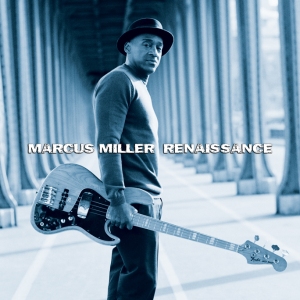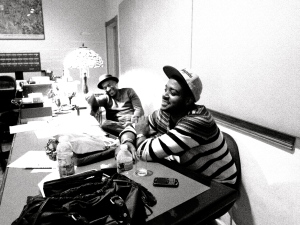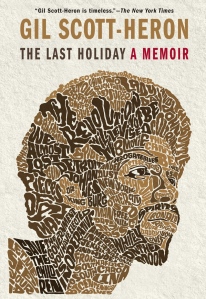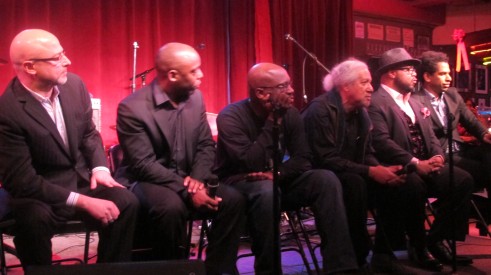As Marcus Miller catches me up on a major project he’d been working on over the last couple years, he stops mid-sentence to give me some background, humbly explaining, “I had produced an album called Tutu for Miles Davis.”
No big whoop, right?
 When you talk to the bassist, composer, producer, arranger, and film scorer, his down-to-earth and disarming demeanor is center stage, while his illustrious career speaks volumes for itself. In the twenty-six years since that landmark album with Davis, Miller has carved out his own distinguished path, setting himself miles apart from the pack. His collaborative efforts include an esteemed list of trailblazers across musical styles and genres including Luther Vandross, Aretha Franklin, Elton John, Mariah Carey and Herbie Hancock. He has also positioned himself as one of the most highly sought after black film scorers in Hollywood while simultaneously enjoying a successful solo career. On Renaissance (Concord Jazz), his eighth studio album as a leader, Miller’s message away from his instrument is just as profound as the music performed by he and his fresh band of dynamic, young players. “I think that music is really just a mirror to whatever’s going on in the world, and we’re just in a time where people are kind of playing it safe,” Miller proclaims. “People are nervous; people are thinking about money all the time, so they’re not taking the chances they used to take. It’s difficult — even if you’re doing something interesting — it’s difficult to get people to hear it. Record companies are just trying to stay in business so they’re not really concerned with presenting new, challenging music. So it’s more like the business people are calling the shots more than they used to. Back in the day, it was the music lovers who called the shots, and then they’d have to explain it to the business people. Not a lot of guys around like that anymore. Everybody’s just trying to keep the doors open. Music and business has always been an uncomfortable relationship, but right now the music is really suffering.”
When you talk to the bassist, composer, producer, arranger, and film scorer, his down-to-earth and disarming demeanor is center stage, while his illustrious career speaks volumes for itself. In the twenty-six years since that landmark album with Davis, Miller has carved out his own distinguished path, setting himself miles apart from the pack. His collaborative efforts include an esteemed list of trailblazers across musical styles and genres including Luther Vandross, Aretha Franklin, Elton John, Mariah Carey and Herbie Hancock. He has also positioned himself as one of the most highly sought after black film scorers in Hollywood while simultaneously enjoying a successful solo career. On Renaissance (Concord Jazz), his eighth studio album as a leader, Miller’s message away from his instrument is just as profound as the music performed by he and his fresh band of dynamic, young players. “I think that music is really just a mirror to whatever’s going on in the world, and we’re just in a time where people are kind of playing it safe,” Miller proclaims. “People are nervous; people are thinking about money all the time, so they’re not taking the chances they used to take. It’s difficult — even if you’re doing something interesting — it’s difficult to get people to hear it. Record companies are just trying to stay in business so they’re not really concerned with presenting new, challenging music. So it’s more like the business people are calling the shots more than they used to. Back in the day, it was the music lovers who called the shots, and then they’d have to explain it to the business people. Not a lot of guys around like that anymore. Everybody’s just trying to keep the doors open. Music and business has always been an uncomfortable relationship, but right now the music is really suffering.”
Miller’s effortlessness at being completely himself oozes out of every corner of Renaissance, and if it’s about risk-taking, he has accomplished said mission on an album which directly references a span of over thirty years of black culture, including songs from Michael Jackson, WAR, and Janelle Monáe. Although for Miller, it’s just a day in the life of a musician bred in the thriving 70s music scene of Jamaica, Queens. “It’s a reflection of the madness in my mind, which sounds really normal to me. It all just sounds like soulful black music. It’s all so related, so I don’t really hear it as eclectic as other people do.” Miller also presents some of his most prolific writing to date, with eight original compositions that showcase his talented band which includes trumpeters Sean Jones and Maurice Brown; alto saxophonist Alex Han; keyboardists Kris Bowers, Federico Gonzalez Peña and Bobby Sparks; guitarists Adam Agati and Adam Rogers; and drummer Louis Cato. The band has been touring extensively over the last two years, and came together around Tutu Revisited, a project started in tandem with the French Miles Davis exhibit, We Want Miles.
“The museum curator who made the exhibit asked me if I would play all the music from Tutu for the exhibit. So I said I would really like to do something in conjunction with this museum. Miles wasn’t really a guy who liked to look back… I’m not sure he would have liked that, but I said maybe if I get some young musicians who could reinterpret it and turn it into something from today, maybe that wouldn’t be so bad, so that’s what I did. I found Alex at Berklee, and he recommended a drummer, and the drummer recommended another musician, and next thing you know, I have this band of 20-something cats, and instead of two gigs, it ended up being two years on tour, because people started getting wind of what we were doing. I felt myself being re-energized with this band. The band before, I had for a long time, and I found myself playing different and playing with a different energy and I kind of got hooked on that feeling.” Like his iconic mentor, Miller now finds himself in similar circumstances — a source of inspiration, organically bridging the generational gap.
“Miles never talked about being a mentor,” says Miller. “I’m not even sure he was consciously trying to be a mentor but just being around him as a young person… that’s how young people usually learn from older people anyway. Not necessarily from hearing them run their mouths, but just observing them and seeing how they run their everyday lives, and I had the benefit of watching him for a little while and how he made decisions and was just getting through life and I think it really affected me. I couldn’t tell you exactly how. The only thing I know is that I try to get the best out of my musicians where they can shine. I try to put them in situations where they can discover something about themselves.”
To his point, Miller carefully crafted the exquisite repertoire found here with this specific group in mind and brought them in on the process, most notably on the arrangement of the 1971 classic, “Mr. Clean”, written by another early mentor and unsung cultural hero — the late, great “Young, Gifted and Black” composer, Weldon Irvine.
“I was born in Brooklyn, but at the age of ten, I moved to Jamaica, Queens, and started my musical life there,” Miller reminisces. “Eventually at about fourteen [years old], I started meeting these bad musicians from Jamaica like Omar Hakim, and Tom Browne and Donald Blackman… and when I first met them, every one of them would refer to Weldon. Weldon was the mentor of the Jamaica cats. He’d put together gigs, because all of us were too young, so he was the one to coordinate and call all the guys together to play, and he was the one after the gig who would have some of us sit in the back of his Chevy Nova and listen to it on cassette (because he would record everything). He’d ask us to explain ourselves… the musical decisions that we made. He’d make us tell him what we had planned for our lives…what our goals were. ‘Mr. Clean’ was like his theme song, and on every gig we’d do with Weldon, we’d play different versions of it. We’d do it really funky and nasty or really jazzy. We had an off day on the road while on tour a couple of years ago, and we decided to rent out a rehearsal studio and we just worked up our own arrangement. It was so great to see these guys discover something I discovered so many years ago.”
Vocalists Dr. John, Rubén Blades and Gretchen Parlato make memorable guest appearances throughoutRenaissance, with Blades and Parlato partnering up on a gorgeous rendition of Brazilian composer Ivan Lins’ “Setembro”. Dr. John is a stunner, dropping New Orleans-flavored rap verses on the Janelle Monáe smash, “Tightrope”.
“I was listening to that Janelle Monáe cut, and I was just like, man this is so sweet! I was listening to that bass line and I said that sounds like one of those New Orleans piano players from back in the day, sort of boogie-woogie. I said I want to do a version of this song and accent the New Orleans aspect of this song and show the roots of where it comes from. With Dr. John, as soon as he says one word, you hear New Orleans. So I called him up and asked him if he’d be interested in collaborating. I said, ‘One thing is you’re going to have to rap, so get ready.’ He said, ‘Man, I don’t know how to rap.‘ I said, ‘Don’t worry, I’ll teach you.’ So I flew to New Orleans and we worked on Big Boi’s rap, and it was a lot of fun.”
Though Miller is now of veteran status, he insists that the inspiration is reciprocal and he is just as passionate about learning from his bandmates. With a band whose members have worked with artists like Beyoncé, Kanye West and Mary Mary, Miller is seeing first hand how his reputation as a limitless musician is influencing the next generation of jazz players, who can sometimes struggle with a community which can be heavily divided at times on matters of authenticity and does not always reward the idea of boundary-pushing.
“I think the biggest thing to consider is that if Charlie Parker had listened to people like that, he would never have ended up playing the way that he did because bebop was so different from the music that preceded it,” Miller says. “And then you can go down the line: If Miles had listened to those people in the 50s, if Trane would have listened to those people, he would never have done what he did. [For] people who are a little less secure, it’s really hard for them to accept new music… because you don’t know the rules yet. All the jazz musicians who I admire like Sonny Rollins; he’s not scared of anything. Herbie Hancock; he’s not afraid. Miles wasn’t afraid. It’s just the kind of people who aren’t that talented and that open, who want to set up the rules because they feel uncomfortable; they know they can’t hang. I know jazz guys who put down funk music, and then I’ll be on a gig, and invite him to come sit it with us, and he gets his head blown off [laughs]! He can’t even get started, because funk music has it’s own set of rules. It has its own requirements. A lot of jazz cats don’t have the tools, and vice versa. Although funk cats are smart enough to stay off the stage! But I’ve played with Aretha Franklin. You wanna put down R&B as a jazz musician? Come with me and sit down while Aretha sings in front of you, and I dare you to pass judgement. Stevie, Luther Vandross, Donny Hathaway — come on! That is the top level of musicality. So you just have to respect these different languages. It’s like, stop being a snob, man.”
It would be impossible to have a career distinction as singular as Miller’s and not have such a philosophy, or at least something close to it. It would be even more unimaginable to be a product of the school of Miles Davis, and not push against the status quo. Miller’s ability to do so both unapologetically and authentically, will likely be a significant part of his legacy, and he’s showing no signs of slowing down.
“It’s people in America who still want their music to be like European classical music… because with European classical music, the book is closed. You can’t write like Mozart anymore, you can’t write like Beethoven. That all happened, so European classical music has a real structure to it now because the book is closed. Once the book is closed you can put music in categories because it all happened and I think that there are a bunch of people in jazz who would like jazz to be the same way. They don’t really feel comfortable with what jazz really is. They’d rather it be America’s classical music, and they’re taking that shit too seriously. They’re trying to make it classical music, and jazz isn’t dead yet. Once it dies then you can say, ‘OK, this is jazz, that’s not jazz.’ As long as you got people out here still making it, you have to suspend the rules.”
** Writer’s Picks: “Detroit”, “Mr. Clean”, “Tightrope”
























